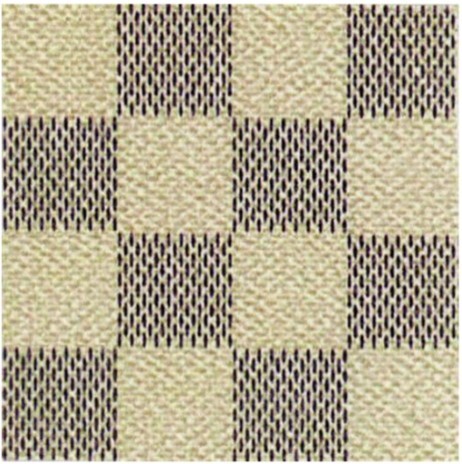Both Burberry and Louis Vuitton Fail to Register Patterns as Trade Marks
Problematic Patterns

Further to our recent article reporting on the EUIPO’s refusal to register a mark comprising a pattern of numbers from 0 to 23 as an EU trade mark (EUTM), Burberry and Louis Vuitton have recently faced similar difficulties when seeking trade mark protection for their iconic patterns before the EUIPO. We consider both cases and the implications for brand owners in the fashion sector.
Burberry application
Burberry applied for the pattern below as an EUTM in February 2022.

Whilst Burberry has registered its iconic design pattern in respect of clothing, the recent application sought protection for “Non-fungible tokens (NFTs) or other digital tokens based on blockchain technology,” “Downloadable virtual goods” and “Downloadable digital materials” amongst other virtual goods in Class 9. It also sought protection for online retail services in Class 35 and entertainment services in Class 41. The EUIPO raised an objection to the application pursuant to Article 7(1)(b) of the EU Trade Mark Regulation on the basis that the application was devoid of distinctive character.
EUIPO decision
In deciding whether or not to uphold the objection, the EUIPO noted that the case law relating to 3D trade marks consisting of the appearance of the product itself, also applied to Burberry’s application. In this case, the mark consists of a sign relating to the appearance of the products it covers. In general, the EUIPO held that a mark consisting of a decorative pattern that is simple and commonplace is devoid of any element that could attract the consumers attention, as well as being insufficient to indicate the source or origin of goods or services. In addition, the EUIPO held:
- The assessment of the distinctive character of the mark is based on the same principles which are applicable to 3D marks
- A combination of elements forming a check pattern is obvious and typical for the goods and not “essentially different” from other check patterns commonly found in trade
- Consumers perceptions for real-world goods can be applied to equivalent virtual goods as a key aspect of virtual goods is to emulate core concepts of real-world goods, and
- The pattern depicted by the mark is not markedly different from various basic patterns commonly used in the trade for the goods and services for which the objection was raised
In taking into account that Burberry failed to submit observations in reply to the objection, the EUIPO upheld the objection and rejected the application for almost all of the goods and services applied for. It was however, permitted to proceed in respect of “Downloadable interactive character, avatars and skins” and “Video games and downloadable video game software” in Class 9 as well as very limited online video game services in Class 41.
Louis Vuitton’s ‘Damier Azur’
The EUIPO also recently came to a similar conclusion in a case involving Louis Vuitton’s famous ‘Damier Azur’ pattern below.

In that case, the EU designation for the above pattern was invalidated on 14 December 2016, following receipt of a cancellation application filed by a third party. The matter was appealed and contested by Louis Vuitton and the case recently came before the General Court of the EU, which delivered a judgment on 19 October 2022. In finding against Louis Vuitton, the General Court of the EU upheld the decision of the EUIPO Fifth Board of Appeal and concluded that Louis Vuitton had not provided convincing evidence of acquired distinctiveness of its Damier Azur pattern. In particular, the Court held that acquired distinctiveness had not been established in Estonia, Lithuania, Latvia, Slovakia, Slovenia or Bulgaria. The General Court re-iterated the EU case law on acquired distinctiveness of a trade mark and held that it was necessary for Louis Vuitton to prove acquired distinctiveness of the Damier Azur pattern throughout the territory of the EU and not only a substantial part or the majority of that territory. The examination which the Court was required to carry out to decide if Louis Vuitton had met the test for acquired distinctiveness through use, was by reference to the actual situation in order to make an overall assessment of the evidence “that the mark has come to identify the goods or services concerned as originating from a particular undertaking.”
Comment
Both of these cases serve as a reminder of the difficulties faced by brand owners when seeking trade mark protection for iconic patterns and sequences, despite how well known the brands and patterns at issue may be. The Burberry decision, which interestingly was not appealed by Burberry, arguably raises more questions than answers for brand owners who are seeking protection for their patterns and designs in the virtual world. It is noteworthy for example, that while the EUIPO found that the Burberry pattern is devoid of distinctive character in relation to virtual clothing goods, Burberry does currently hold a EUTM registration for the same pattern protecting physical clothing goods in Class 25. The Louis Vuitton case on the other hand, reinforces the difficulties associated with establishing that a trade mark has acquired distinctiveness as a result of the use made of it. Unfortunately for brand owners, the bar set by the EU case law in relation to proving acquired distinctiveness is a very high one. Brand owners faced with the task of seeking to meet this bar should recall that design applications may provide a less onerous path to obtaining IP protection for their iconic patterns, provided that the requirements of novelty and individual character are met.
For more information on successfully protecting your organisation’s intellectual property rights, contact a member of our Intellectual Property team.
The content of this article is provided for information purposes only and does not constitute legal or other advice.
Share this:



